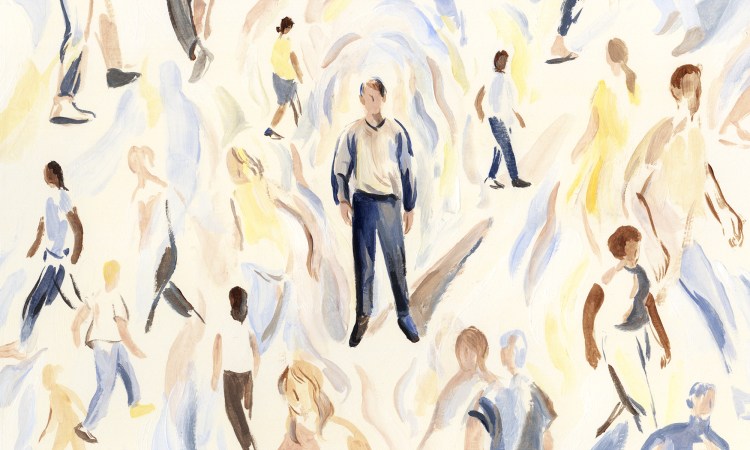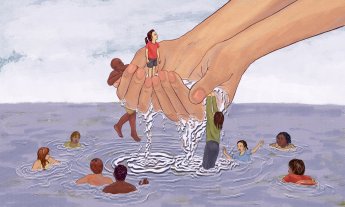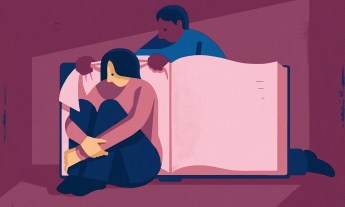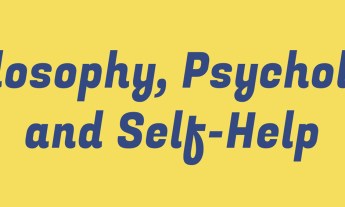
We tend to think of prejudice as something that other people, particularly bad people, have in their hearts and minds.
The truth is, prejudice is inside us all. The good news is that psychology provides a powerful way to combat it.
Prejudice is due in part to cultural learning, from our parents, our schools and social messages and depictions in the media. But prejudice is also deeply embedded into our thought networks. Numerous studies have been done on implicit bias, the negative stereotyping and othering that we are not consciously aware of.
Whether we like it or not, prejudice easily digs into us. So if we’re going to combat it, we need to change how our minds deal with it.
Since I was a young child, I’ve been pained by the brutality of prejudice and how it impacts us all. I’ve also learned how profoundly it shaped the lives of my Jewish ancestors, and I’ve witnessed it directed at my children who are multiracial.
Growing up, I did not know that my mother had been told by her father — who had become swept up by the fervor of Hitler-era Germany — never to tell anyone she had “tainted blood.” My mother’s name was not Ruth Eileen Dreyer, as she claimed, but Ruth Esther Dreyer. It was only later I learned that fact and that half of her maternal aunts and uncles died crowded into “shower rooms” meant not to cleanse them, but to cleanse the world of them.
I first encountered prejudice in my childhood friend Tom, who was white like me. He spewed venom about people of other races and ethnicities, calling them the n-word and other foul names. It bothered me, and I even got into a fistfight with him over it.
Regardless of my contempt for them, his slurs sank into my mind. One day, Tom and I — along with our friend Joe — rode our bikes to a bowling alley to play a game.
As we set up, Tom strangely commented, “It looks like rain.” He and Joe giggled. I was confused. From where we were, we couldn’t see the outside.
“It looks like raaaain,” Tom repeated loudly as he and Joe tried to repress their laughter.
Finally, I noticed a Black man walking toward us — a dark cloud was rolling in. Get it?
I was horrified, and I felt sick to my stomach. But the thought also flittered into my mind that I was glad they weren’t making fun of me.
Flash forward a couple of decades. My then-teenage daughter Camille was dressed up for a school dance, looking absolutely wonderful. She is Afro-Latina-American (my first wife was Latina, Camille was her child from a previous relationship, and I adopted her).
As I watched her approach, a voice bubbled up inside my head, unbidden and unwelcome. The auditory equivalent of a smirk, it was Tom’s voice, saying very clearly, “It looks like raaaain.”
Last year, I told the story of Tom’s voice popping into my head to Camille.
Her response was sweet and pure. “I love you, Daddy,” she said. “We all have burdens like that to carry.”
Yes, we do.
Negative stereotypes pervade people’s lives. Even if you hate them — or are the victim of them — they are in your cognitive network. That means they are available to do mischief, even when you’re not conscious of it. If you go to the rigid, defended, frightened, angry, judgmental parts of your own heart, you will see that bias resides there.
But you can learn to use that recognition, and apply it to reduce the harmful impact of that part of you and the chance that your privilege and prejudice could be passed to others. By applying the practices of acceptance and commitment therapy — which focus on cultivating psychological flexibility rather than struggle and avoidance — to investigate your implicit biases, you become more aware of them and bring your actions in line with your conscious beliefs. This kind of mindful awareness allows prejudicial thoughts to become less dominant, and studies show it can even help us commit to positive actions to combat prejudice.
My lab researched this. We studied many forms of prejudice, including gender bias, weight bias, bias based on sexual orientation, ethnicity and more. We expected to find a common core, and we did.
We found that all forms of prejudice can be largely explained by what’s called authoritarian distancing — the belief that we are different from some group of “others” and because they are different, they represent a threat that we need to control.
When my lab examined the psychological factors led some people to settle into authoritarian distancing, we found three key characteristics:
- the relative inability to take the perspective of other people;
- the inability to feel the pain of others when you do take their perspective;
- the inability to be emotionally open to the pain of others when you do feel it.
Drawing on our findings, we developed interventions that have been found to significantly reduce prejudice.
In some ways, the most difficult to eradicate forms of bias are invisible and unconscious because they are based on privilege. For example, a white person can honestly say “I don’t think about race”, but she’s not aware of how much that exudes privilege when her Black neighbor has no choice but to think about it — she sends her teenage son out into the world every day, knowing that he is more likely to be arrested or shot at because he is Black.
Similarly, a man can believe that he is without gender bias but still talk more than — and over — his women colleagues in meetings.
Because it’s unfair and irresponsible to ask those who bear the costs of privilege to do all the heavy lifting to correct it, the first step is to look at your own behavior. Try to notice your indirect indicators of bias — the times in which your supposedly unbiased actions are actually rooted and shaped by your privilege.
As you’re doing this, ask people who are close to you and who’ve experienced bias if they can help you. For example, when I start mansplaining, my wife gives me a look. Do not expect this to feel good, but it’s a worthy journey.
Here are 3 steps that you can take to start recognizing and disarming your own prejudice:
1. Own your bias
Observe any tendencies to judge others or yourself or to enact bias based on privilege. Bring as much self-compassion and emotional openness to that awareness as you can. When do you notice prejudicial thoughts or biased actions popping up?
Let go of any tendency to buy into your judgement or make them more important by avoiding them or criticizing yourself for hosting them. These are thoughts, feelings, and invisible habits, and they are yours. You are responsible, but you are not to blame.
Just note their existence and increase your awareness of the negative cultural programming that we all carry.
2. Connect with other people’s perspective
Deliberately take the perspective of those whom your mind judges, feeling what it’s like to be subjected to stigma and bias, sometimes without conscious awareness by the person doing harm.
Don’t run from the pain of seeing those costs, or allow it to slip into guilt or shame. The goal is connection and ownership.
Allow the pain of being judged or being hurt to penetrate you. As you do, bring your awareness to how causing anyone that kind of pain goes against your values.
3. Commit to change
Channel the discomfort of ownership and the pain of connection into a motivation to act. Commit to concrete steps that you can take to reduce the effect of prejudice and stigma on others.
This could mean learning to listen more; speaking out when another person makes light of prejudice; stepping back so others can step forward; joining an advocacy group; getting to know people who belong to groups that your mind judges.
Taking these actions is not meant to erase what you are carrying and experiencing but to channel those feelings toward expressing compassion.
You can practice these steps regularly. As you begin to loosen the grip of your implicit biases, you’ll find that your enjoyment of being with people of all kinds increases, no matter how different they may have once seemed to you.
The sad fact is if we’re not helping solve the problem of prejudice, we are helping to perpetuate it. And if we don’t learn to acknowledge our privilege or catch the subtly prejudicial thoughts that go through our minds, we are supporting bias — and potentially passing it on.
It’s hard to admit to ourselves that we’ve been complicit, and it’s hard to diminish the impact of bias. But with work, we can do it.
Excerpted with permission from the new book A Liberated Mind: How to Pivot Towards What Matters by Steven C. Hayes. Published by Avery, an imprint of Penguin Random House, LLC. © 2020 by Steven C. Hayes.
Watch his TEDxUniversityofNevada Talk here:











